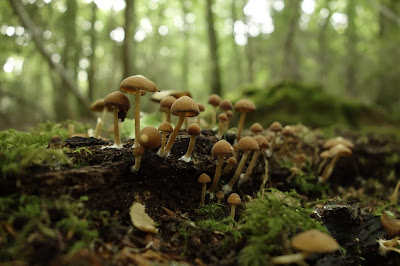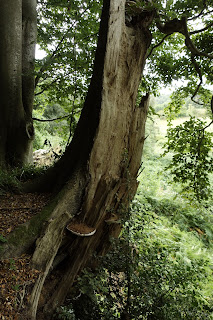Had my first trip out with the Sussex Fungus Group on Saturday at
Birchden Wood, near Groombridge.
I rarely venture this far into the north of East Sussex but the journey made me feel I should come more often. Past Maresfield, I took the scenic route through Fairwarp, Duddleswell and Hartfield,
enjoying the views across Ashdown Forest.
Having been too disorganised to bring lunch, I hoped there'd be a bakery when I got to Groombridge and I wasn't disappointed.
The Village Bakery furnished me with a 'Sussex pasty' and I pressed on to Birchden Wood and my rendezvous with the Sussex Fungus Group.
Over the course of this year, as I've laboured over identifying (or trying to identify) each mushroom I've found, I have occasionally wondered how I'll cope when the main season hits. How will I make sense of the autumnal abundance of fungi?
I don't have a head for lists, so trying to remember the name of every species that's pointed out to me is hopeless. Making the observation is the interesting bit for me: learning something
about what I'm looking at. I decided I'd focus on getting my head around the different families of fungi and not worry too much about remembering the species names. If I could remember a few of the more distinctive species
– so much the better.
Arriving at car park I found Nick Aplin and Martin Allison were there to lead the foray. Once everyone had arrived, we were seven, and we headed into Birchden Wood.
The first section we came across was mixed woodland. Nick, who has an eye for the small stuff, quickly turned up
Twig Parachute Marasmiellus ramealis among the leaf litter.
Not far away, he also found
Marasmius rotula, a rather similar-looking species except
M. rotula has this collar around the stem. Apparently,
Marasmiellus species never have a collar, so that's one way to tell which family you're in.
 |
| Marasmius rotula with its distinctive collar. |
In the same stretch of woodland, Martin found an interesting
Cortinarius (or 'Webcap') species, with Poplar.
I don't think I've knowingly seen a
Cortinarius before. Here's Martin showing me the web-like strands which cover the gills of the young mushroom.
Nick found another specimen showing the cobweb-y veil at the top of the stipe which has caught the rust-coloured spores.
It wasn't possible to identify this
Cortinarius to species in the field, so Martin took a specimen to determine at home.
As we walked through the woodland, we saw a few
Russulas poking up through the leaf litter. I'd rather got the impression that
Russulas are impossibly hard. But Martin said he finds them fairly easy. Well, I guess everything's easy when you know how, but I can see what he meant
– there's a logic to identifying Russulas.
Martin carried with him an iron sulphate crystal (more fungus-hunting paraphenalia!) – rubbing this against the stipe creates a chemical reaction which colours differently in different species. The extent to which the cap peels away is also a key feature. And taste, although I wasn't quite brave enough to try this.
From the mixed woodland, we crossed a large patch of sphagnum and headed into birch woodland. Not a great deal of fungus on display here, but Martin did find an impressive Chicken of the Woods Laetiporus sulphureus which I recognised immediately as the same thing I'd seen at Woods Mill earlier in the year. I embarrassed myself at this point, blurting out, "Turkeytail!" as my brain had made the wrong poultry connection. Thankfully people were very understanding and a conversation ensued about the surprising number of fungus species with poultry-related names (see also, Hen of the Woods).
Around here we saw quite a few Common Earthballs Scleroderma citrinum.
These were considerably bigger than the earthballs I've seen previously (see
here and
here) which makes me think I've been misidentifying them.
Emerging from the birch woodland, we strolled down a dirt track with a narrow grassy strip at each side. As we approached a junction, I saw some large-ish mushrooms poking up through the grass.
It turns out these were a
Melanoleuca species (or 'Cavaliers'). I was surprised to note these mushrooms
– with their flattish beige caps, creamy white gills and tall stems so-slender it's a wonder they can hold the cap up
– drew surprisingly little enthusiasm from our group of forayers.
Here we are, being not-very-enthusiastic:
Nick explained that, as a group, the
Melanoleuca are not well-described and the species concepts are often ambiguous or conflicting. So it's hard to identify these to species level with real certainty. After some hesitation, Martin decided he'd rise to the challenge and took a specimen home for further examination.
At the top of the slope, we came to a beech woodland (with so many habitats to choose from, I was beginning to see why this had been chosen as a foray destination). Here we came across a few species I recognised:
Blushing Bracket Daedaleopsis confragosa, Yellowing Curtain Crust Stereum subtomentosum (although I took it for Turkeytail at first),
Dead Man's Fingers Xylaria polymorpha and
Green Elfcup Chlorociboria aeruginascens, fruiting rather splendidly.
Emerging from the beech woodland, I was rather delighted when we came across this
Stinkhorn Phallus impudicus, growing in association with a beech root.
Here it is in all its glory.
From there we headed down through a conifer plantation, where it was rather too dry to find any more fungi, back to the car park.
That is the end of my first foray with the Sussex Fungus Group.
But, if you remember, I had a pasty to eat. So there is a minor post-script to this story as I wandered in the direction of
Harrison's Rocks to find a nice place for a spot of lunch.
Atop one of the sandstone outcrops, I spotted something.
A handsome bracket fungus growing on the broken trunk of a beech tree.
It's one of THESE!
Either
Southern Bracket Ganoderma australe or
Artist's Bracket Ganoderma applanatum.
And, in case you're wondering, the pasty was one of the best I've ever had.
For the record:
Date: 3 September 2016
Location: Birchden Wood
Grid reference: TQ5336 / TQ5335
All records to be submitted by Nick Aplin / Martin Allison on behalf of Sussex Fungus Group





























